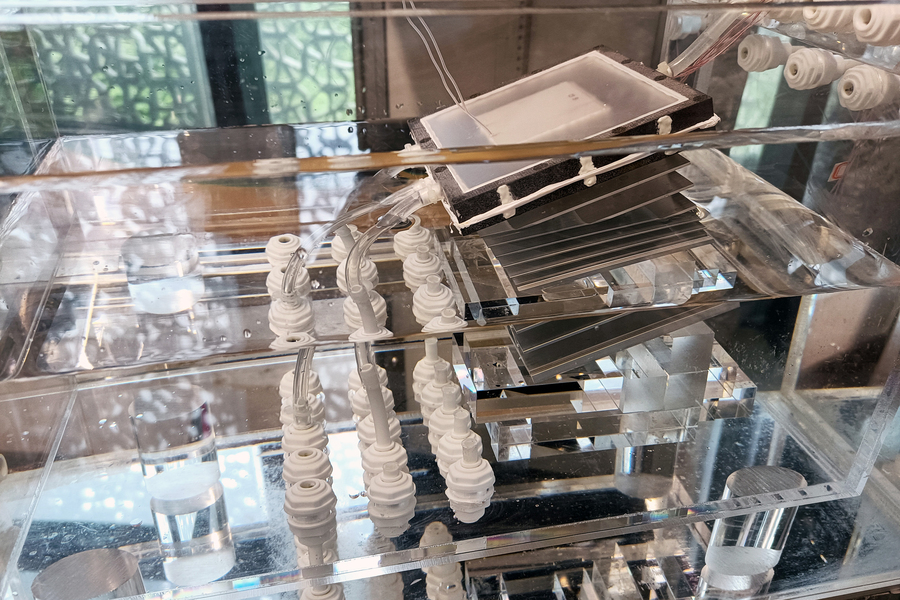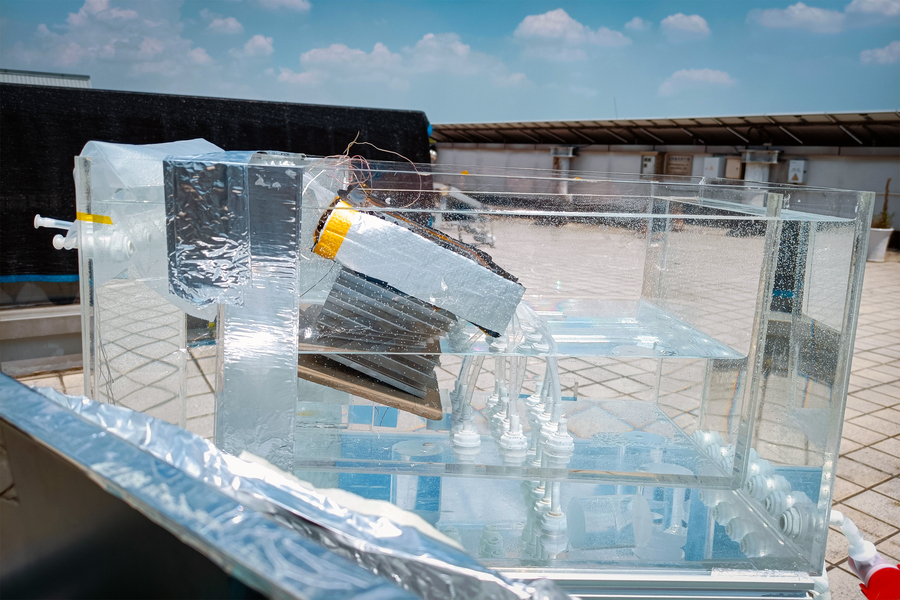Skip to comments.
Desalination system could produce freshwater that is cheaper than tap water
MIT News ^
| September 27, 2023
| Jennifer Chu
Posted on 01/14/2024 6:08:09 PM PST by SunkenCiv
The team's new system improves on their previous design — a similar concept of multiple layers, called stages. Each stage contained an evaporator and a condenser that used heat from the sun to passively separate salt from incoming water. That design, which the team tested on the roof of an MIT building, efficiently converted the sun's energy to evaporate water, which was then condensed into drinkable water. But the salt that was left over quickly accumulated as crystals that clogged the system after a few days. In a real-world setting, a user would have to place stages on a frequent basis, which would significantly increase the system's overall cost.
In a follow-up effort, they devised a solution with a similar layered configuration, this time with an added feature that helped to circulate the incoming water as well as any leftover salt. While this design prevented salt from settling and accumulating on the device, it desalinated water at a relatively low rate.
In the latest iteration, the team believes it has landed on a design that achieves both a high water-production rate, and high salt rejection, meaning that the system can quickly and reliably produce drinking water for an extended period. The key to their new design is a combination of their two previous concepts: a multistage system of evaporators and condensers, that is also configured to boost the circulation of water — and salt — within each stage.
(Excerpt) Read more at news.mit.edu ...
TOPICS: Science
KEYWORDS: california; ccp; china; desalination; israel; massachusetts; mit; putinista; science
Navigation: use the links below to view more comments.
first 1-20, 21-30 next last
1
posted on
01/14/2024 6:08:09 PM PST
by
SunkenCiv
The rest of the desalination keyword, sorted:
2
posted on
01/14/2024 6:08:43 PM PST
by
SunkenCiv
(Putin should skip ahead to where he kills himself in the bunker.)
To: AdmSmith; AnonymousConservative; Arthur Wildfire! March; Berosus; Bockscar; BraveMan; cardinal4; ...
[subtitled] MIT engineers and collaborators developed a solar-powered device that avoids salt-clogging issues of other designs.
3
posted on
01/14/2024 6:09:39 PM PST
by
SunkenCiv
(Putin should skip ahead to where he kills himself in the bunker.)
To: SunkenCiv
Cough cough, uh huh right.
4
posted on
01/14/2024 6:12:33 PM PST
by
yldstrk
To: SunkenCiv
they invented a pool?.....................
5
posted on
01/14/2024 6:28:59 PM PST
by
Red Badger
(Homeless veterans camp in the streets while illegal aliens are put up in hotels.....................)
To: SunkenCiv
This water would be as cheap to produce as electricity is cheaply produced from windmills and solar panels.
My point is this system may work great in a lab/scientific environment. But to get water to evaporate using the sun will take an awful huge operation to satisfy the needs of a small 50,000 population town.
I have a feeling the cost per gallon of water will exceed that of a conventional reverse osmosis system once all expenses of production are considered.
6
posted on
01/14/2024 6:33:38 PM PST
by
redfreedom
(Joseph Stalin: "It does not mater how anyone votes, how votes are counted is what matters.")
To: SunkenCiv
Where does the salt eventually go?
Wintertime road treatment to dissolve ICE engined cars?
7
posted on
01/14/2024 6:36:20 PM PST
by
Paladin2
To: Paladin2
Walmart and Dollar Tree, for examples.
8
posted on
01/14/2024 6:36:57 PM PST
by
SunkenCiv
(Putin should skip ahead to where he kills himself in the bunker.)
To: Red Badger
“Please don’t pee in our pool, we don’t swim in your toilet.” — sign common to backyard pool areas in the 1960s
9
posted on
01/14/2024 6:38:45 PM PST
by
SunkenCiv
(Putin should skip ahead to where he kills himself in the bunker.)
To: redfreedom; SunkenCiv
It is shameful we are in this state with water.
Israel is the world leader in desalination. We need it. We should have it.
What we lack is the will to do it.
Our approach to water supply is akin to our energy approach: a shambles and a farce.
10
posted on
01/14/2024 6:42:46 PM PST
by
rlmorel
("The stigma for being wrong is gone, as long as you're wrong for the right side." (Clarice Feldman))
To: SunkenCiv
Multiple references to cost advantages, but no specifics. I automatically dismiss such puffery as being for the sole purpose of getting the next grant.
To: SunkenCiv
Too damn slow. Hook it up to a coal plant.
To: rlmorel
Israel's got a high per capita of scientists and engineers, also has greater motivation since the muzzies have defoliated every place they've controlled for long periods of time, and of course water is needed for survival and prosperity.
13
posted on
01/14/2024 6:50:02 PM PST
by
SunkenCiv
(Putin should skip ahead to where he kills himself in the bunker.)
To: SunkenCiv
All true.
Of course, water is needed for our survival and prosperity too. The way California has handled water resources is shameful, and many other parts of the country are not far behind it.
14
posted on
01/14/2024 6:52:45 PM PST
by
rlmorel
("The stigma for being wrong is gone, as long as you're wrong for the right side." (Clarice Feldman))
To: SunkenCiv
Well navy ships have evaporators. The most expensive part of that is the energy required to heat sea water 150 degrees so the salt water will flash to steam which is then condensed. Aircraft carriers have 4-100000 gpd stills. So the evaporative method is proven. Get the energy cost down and it becomes cost effective.
15
posted on
01/14/2024 6:53:06 PM PST
by
msrngtp2002
(Just my opinion.)
To: rlmorel
Cali's primary problem is that it's a single party state, or as the Cali Demagogic Party pols like to call it, a "durable majority".
16
posted on
01/14/2024 7:00:49 PM PST
by
SunkenCiv
(The Demagogic Party is a collection of violent, rival street gangs.)
To: redfreedom
How does it work in the Winter at higher Latitudes?
17
posted on
01/14/2024 7:01:43 PM PST
by
Paladin2
To: SunkenCiv
Oh, yeah. I live in a state with just that setup...:(
18
posted on
01/14/2024 7:14:13 PM PST
by
rlmorel
("The stigma for being wrong is gone, as long as you're wrong for the right side." (Clarice Feldman))
To: SunkenCiv
Aruba has an incredible desalination system. It’s crazy they had not used this technology here.
19
posted on
01/14/2024 7:21:38 PM PST
by
HollyB
20
posted on
01/14/2024 7:22:35 PM PST
by
HollyB
Navigation: use the links below to view more comments.
first 1-20, 21-30 next last
Disclaimer:
Opinions posted on Free Republic are those of the individual
posters and do not necessarily represent the opinion of Free Republic or its
management. All materials posted herein are protected by copyright law and the
exemption for fair use of copyrighted works.
FreeRepublic.com is powered by software copyright 2000-2008 John Robinson

